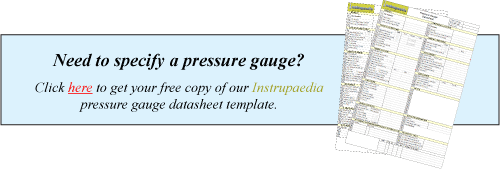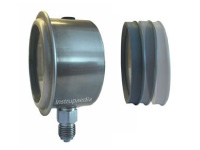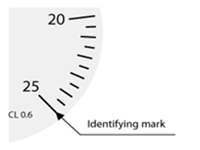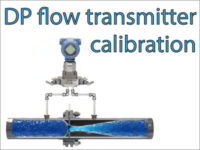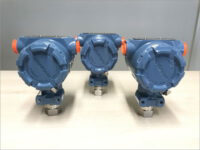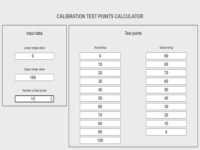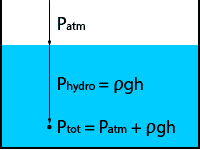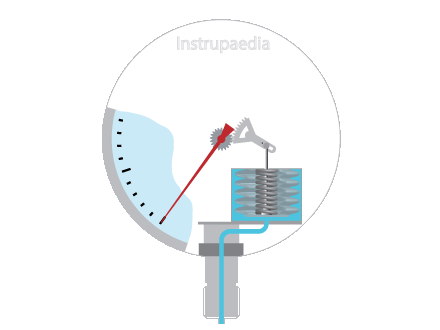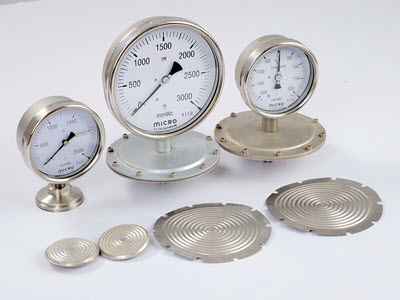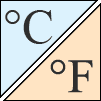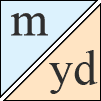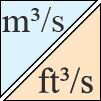Bourdon tube pressure gauge
9 May 2022
C-type Bourdon tube
The Bourdon tube pressure gauge consists of a circular tube that is bent over an angle of generally 270°, and of which one end is closed and the other is connected to the process pressure.
The closed-end can move freely. This movement is transmitted via a transmission mechanism to the pointer of the pressure gauge, as you can see in the pressure gauge animation.
With the rack and pinion of the transmission mechanism, the movement of the Bourdon tube may be amplified so that the pointer rotates from start to end of the scale.
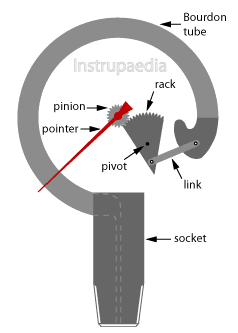
“Check out other pressure gauge animations:”
The Bourdon tube behaves like a spring that is deformed by the internal pressure in the tube.
To retain the pressure, the tube must have a certain wall thickness. Larger wall thicknesses are required for measuring higher pressures.
The wall thickness, the shape of the tube’s cross-section, the diameter of the C-shape, and the kind of material from which the tube is manufactured are determining factors for the elasticity of the Bourdon tube.
It is clear that a metal tube of sufficient thickness to hold the pressure is not enough elastic to create sufficient tip movement under the influence of small internal pressure. Bourdon tubes are, therefore, only used for measuring higher pressures.
In practice, this measuring principle can be found for measuring ranges between 0.6 bar (9 psi or 60 kPa) and 7000 bar (105,000 psi or 700,000 kPa).
The C-shaped tube is used for the lower measurement ranges up to about 60 bar (900 psi, or 6000 kPa). For higher measuring ranges spiral or helical Bourdon tubes are used.
A Bourdon tube is usually flattened on one or both sides. This allows the tube to lose some of its rigidity which makes it easier to uncoil when pressurized.
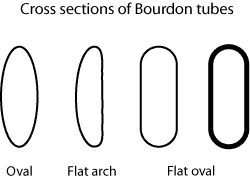
As the Bourdon tube has a circular form, the outer radius will be larger than the inner radius. The pressure in the Bourdon tube acts on a larger surface area along the outer radius and, consequently, will develop a larger force on that side so that the tube will straighten out.
The movement of the free end is non-linear as the same pressure increase at a Bourdon tube at rest has a greater effect on the displacement of the free end than when the tube has already been partially straightened. The reason for this is the resistance of the tube that increases when it becomes more straightened.
To be able to indicate the pressure on a linear scale, this nonlinearity must be compensated for by the transmission mechanism. Without compensation, the nonlinearity can reach up to 0.5% full scale. Cyclic pressures will cause an additional hysteresis of 0.2 to 0.5% of full scale.
In any case, this hysteresis may not be higher than the accuracy class of the pressure gauge.
The Bourdon tube is also sensitive to temperature changes. At low temperatures, the tube will be much stiffer and more difficult to straighten.
To keep this temperature effect as small as possible the construction material of the tube should be well chosen. Materials having a modulus of elasticity that is insensitive to temperature change are recommended.
Fast response time and good sensitivity are among the more desirable features of the Bourdon tube.
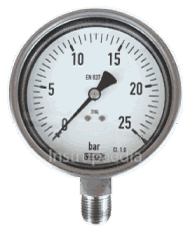
The accuracy is situated between +/- 0.1 to +/- 5% of full scale and is determined by the Bourdon tube diameter, the wall thickness and the shape of the tube’s cross-section, the quality of the design, and the calibration. Incorrect installation or improper use can also cause a loss of accuracy.
Usually, a Bourdon tube pressure indicator is mounted vertically. Deviations of +/- 5° relative to the vertical position are permitted. A deviation of more than 5° will have an impact on accuracy.
When measuring the pressure of a liquid, the initially air-filled Bourdon tube will be filled up with liquid. As a result, air will be trapped by the liquid at the tube-end. This results in a sluggish performance of the pressure indication. A pressure gauge with a diaphragm and a liquid-filled Bourdon tube is a better choice in this case.
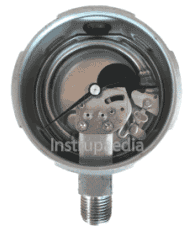
The large overhanging free end of the Bourdon tube makes this measuring principle sensitive to vibrations.
When vibrations occur, the overhanging part will make small up and down movements. The transmission mechanism ensures that this movement is amplified and passed on to the pointer. As a result, the pointer will constantly move back and forth, making accurate reading impossible.
By immersing the Bourdon tube in a fluid (filling of the casing), the motion of the pointer can be damped. Glycerine is often used for this purpose. The liquid may be added through an opening on top of the casing which is then closed with a rubber plug. The filling continues until the Bourdon tube is fully submerged.
The fill fluid also prevents humidity from entering the enclosure. Fluctuations of the ambient temperature will otherwise create a kind of “breathing effect” inside the enclosure. Humid ambient air comes in, mostly at night, when temperatures are falling. With rising temperatures, air goes out again. When the dew point is reached, this humidity will condense causing corrosion of internal components and interior condensation on the window. All of this can be avoided by filling up the enclosure with glycerine.
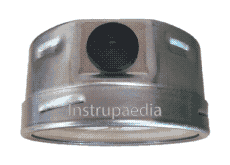
Cyclic pressures have the same effect on the pointer as vibration.
The best way to get a stable readout is to use a snubber at the inlet of the pressure gauge. The fluid supplied to, or discharged from the Bourdon tube will be slowed down by the snubber and the pendulum movement of the pointer will be smaller and slower.
Filling the casing with glycerine may also help to dampen the pendulum motion of the pointer.
The frequent back and forth movement of the pointer will have an adverse effect on the wear of the rack and pinion.
Bourdon tube pressure gauges can be executed according to a safety design to protect the operator from high-pressure liquid or gas projections through the window of the pressure gauge in case the Bourdon tube should rupture.
We distinguish the design types S1, S2, and S3. For the S1 type, the housing of the pressure gauge is equipped with a blow-out device (black plastic plug in the picture below).
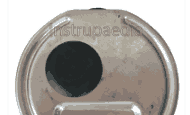
Gas or liquid being released is evacuated to a safe area away from the operator.
The window of the pressure gauge may additionally be made of safety glass. The blow-out device is activated at a pressure that is lower than half of the window-burst pressure.
Safety pattern gauges are of the S2 or S3 type and ensure
Pressure gauges with a diameter between 40 and 80 mm, without an internal baffle wall, are of the S2 type and have a blow-out back. The blow-out back is usually the entire back of the pressure gauge and is blown away when the enclosure is being pressurized. The pressure in the enclosure is allowed to rise to a maximum of half of the pressure that is needed to break the window.
Pressure gauges with a diameter between 40 and 250 mm with an internal baffle wall are of the S3 type and also have a blow-out back. A baffle wall is a solid plate that is located between the Bourdon tube and the window. Upon failure of the Bourdon tube, the baffle wall will protect the window from being pressurized and the build-up pressure will blow away the blow-out back.
Both the S2 type and the S3 type are having windows made of safety glass.
Bourdon tube pressure gauges are fabricated according to certain standards. There are, among others, the European standard EN 837-1 and the US ASME B40.100. These standards provide terminology and definitions, dimensions, safety, construction and installation issues, test procedures, and general recommendations.
This video of the Australian company Floyd Instruments shows how pressure gauges are manufactured and uses beautiful graphics to further illustrate the functioning of the Bourdon tube pressure gauge.
Or here’s another one from the company Wika that shows the manufacturing process of a Bourdon gauge.
Spiral type Bourdon tube

The spiral Bourdon tube makes a few windings in one plane around the fixed shaft of the pointer.
When the tube is being uncoiled by the process pressure, the free end will have a larger displacement compared to the C-shaped tube. The more windings, the larger the displacement will be.
A transmission mechanism is therefore no longer necessary. When the number of windings is correctly determined for a selected measuring range, a fixed connection between the free end of the Bourdon tube and the pointer is sufficient for a full deflection on the scale.
Using a fixed link avoids transmission losses due to friction or backlash in the transmission mechanism. This increases the accuracy and sensitivity of the pressure gauge. Also, recalibration is no longer necessary.
Backlash is mainly caused by wear on the teeth of the gears. Vibrations and pulsations are making it even worse. A pressure gauge with backlash on the gears will always indicate a pressure that is too low or too high. Subjected to pulsations, the backlash will cause the pointer to rotate further in both directions than would normally be the case without backlash. Having a fixed link is making the spiral Bourdon tube pressure gauge very resistant to extreme vibration or pulsation.
For low-pressure ranges, the spiral is made of a flat oval tube, while a round tube is being used for the high-pressure ranges.
The same low pressures can be measured with the spiral Bourdon tube as with the C-shaped Bourdon tube but the cost for a spiral pressure gauge is higher.
The use of spiral Bourdon tubes is consequently more likely in the high-pressure ranges which cannot be measured with the C-shaped tube because the wall thickness of the tube would be too large so that the tip movement is too small to have sufficient accuracy.
A clear representation of the operation of a spiral Bourdon tube is shown in this video from the company WIKA Instrument LP.
Helical type Bourdon tube
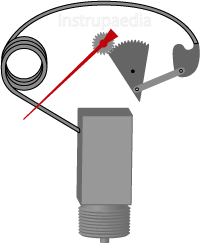
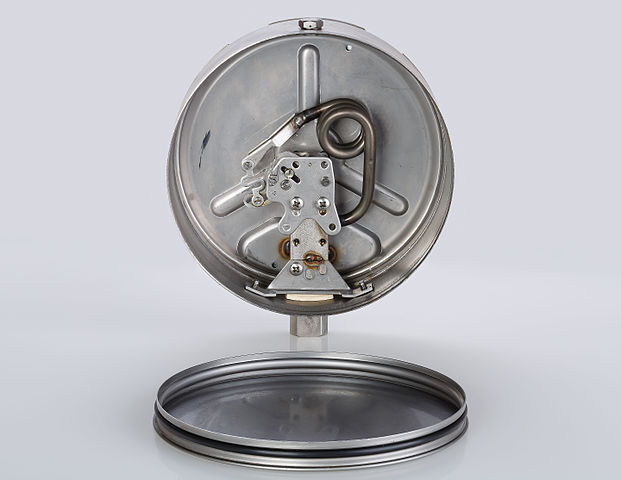
The helical Bourdon tube has several turns winded into a helix. The number of coils can vary from two or three to as many as twenty. They can be equipped with or without a transmission mechanism.
With 2 to 3 windings, as shown in the picture, the measuring range will rather be small and a transmission mechanism will be necessary to amplify the movement of the free end.
Having 16 to 20 windings, a larger measuring range becomes possible without the need for a transmission mechanism because the movement of the free end is large enough on itself.
When using a transmission mechanism, less movement of the free end is required which leads to less stress in the Bourdon tube. The fatigue life is thereby improved when compared to a C-shaped Bourdon tube.
The measurement range, however, is not only determined by the number of windings but also by the diameter, the wall thickness, and the type of material from which the Bourdon tube is manufactured.
Having more windings also increases the total volume of the Bourdon tube. This internal volume acts as a buffer for fluctuations in the process pressure. In this way, fluctuations are better absorbed, and the pointer will remain stable.
Due to the helically shaped design, this type is more robust than the spiral type. As a consequence this design is primarily used for large measurement ranges up to 7000 bar (105,000 psi or 700,000 kPa). On top of that, larger overpressures are permissible.
The accuracy of this type of gauge is normally found around +/- 1%.
Datasheet template
An easy configurable Excel template is available for specifying Bourdon tube gauges. With this pressure gauge datasheet, all three types of Bourdon tube pressure gauges discussed above can be defined.
Datasheet templates for other types of instruments can be found in the datasheet library.
Related topics
Leave a Comment
Your email address will not be published. Fields marked with * are required.


